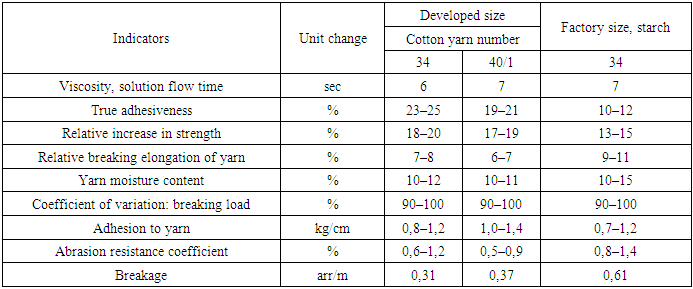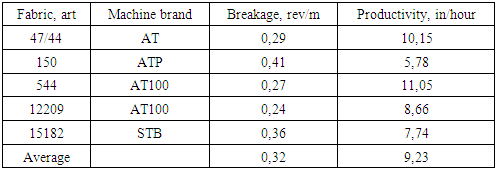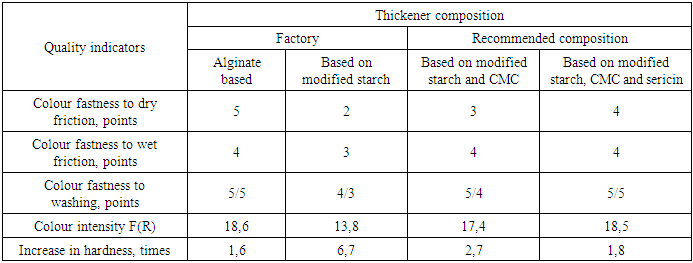-
Paper Information
- Paper Submission
-
Journal Information
- About This Journal
- Editorial Board
- Current Issue
- Archive
- Author Guidelines
- Contact Us
International Journal of Materials and Chemistry
p-ISSN: 2166-5346 e-ISSN: 2166-5354
2024; 14(6): 103-108
doi:10.5923/j.ijmc.20241406.02
Received: Dec. 16, 2024; Accepted: Dec. 29, 2024; Published: Dec. 31, 2024

Study of the Composition of Sizing and Its Impact on the Properties of Sizing Yarn
Rano Akhadovna Ismatova1, Avaz Sanokulovich Kazakov2, Matluba Mukhtarovna Amonova3
1Doctor of Philosophy (PhD) in Technical Sciences, Associate Professor, Bukhara State Medical Institute, Bukhara, Uzbekistan
2Lecturer, Academic Lyceum of Bukhara State Medical Institute, Bukhara, Uzbekistan
3Doctor of Philosophy (PhD) in Chemical Sciences, Associate Professor, Bukhara Institute of Innovative Education and Medicine, Bukhara, Uzbekistan
Copyright © 2024 The Author(s). Published by Scientific & Academic Publishing.
This work is licensed under the Creative Commons Attribution International License (CC BY).
http://creativecommons.org/licenses/by/4.0/

The goal of the given scientific work is to discuss new development of sizing composition and its impact on basic mechanical properties of sizing yarn. Some disadvantages of traditional synthetic sizing agents, such as high cost and complicated processing, influence the yarn being treated. In this context, a new composition was developed which includes starch, polyvinyl alcohol, and hydrolyzed polyacrylonitrile. The main objective was to reduce edible starch consumption while simultaneously improving the mechanical properties of yarn. The research, via systematic experimentation and analysis, tried to obtain the ideal ratio of components in the sizing composition to produce superior physicochemical interactions. Among key findings is the enhancement in yarn tensile strength by 25% and reduction in breakage rates during weaving by 30%, along with a tremendous improvement in machine performance compared with traditional starch-based sizing methods. These result not just in improved yarn strength but also reduce machine idle time and cost of upkeep, enhancing the overall production efficiency of the system. Besides that, the work also involves greener alternatives in textile processing through the development of thickening agents suitable for sustainable methods in fabric printing. These showed very good colorfastness combined with low fabric stiffness, meeting industrial objectives for sustainability and quality in textile production. This work thus lays the foundation for the development of environmentally responsible practices with enhancements in performance and efficiency in textile manufacturing.
Keywords: Composition, Flexibility, Sizing, Elasticity, Strength, Impact, Properties, Sizing yarn, Components, Fibers, Yarn production process, External influences, Technological process, Textile production, Physicochemical conditions, Polyvinyl alcohol (PVA), and hydrolyzed polyacrylonitrile (HIPAN), Macromolecules, Electronegativity, Cotton yarn, Textile sustainability, Colorfastness, Textile processing
Cite this paper: Rano Akhadovna Ismatova, Avaz Sanokulovich Kazakov, Matluba Mukhtarovna Amonova, Study of the Composition of Sizing and Its Impact on the Properties of Sizing Yarn, International Journal of Materials and Chemistry, Vol. 14 No. 6, 2024, pp. 103-108. doi: 10.5923/j.ijmc.20241406.02.
1. Introduction
- Sizing of yarns is very important in modern textile industries to improve the mechanical and processing properties of yarns so that they can be woven on high-performance looms. Conventional sizing agents include food-grade starch, which has been widely used due to their easy availability and effectiveness. However, consumption of these materials raises huge concerns regarding resource sustainability and economic feasibility considering the ever-growing global demand for food products.Synthetic sizing agents, being homo- and copolymers, were introduced to surmount all these challenges. In such regards, synthetic agents have the advantage of sizing without the use of food-grade materials and show advantages regarding uniform film formation and high adhesion to fibers. They have a number of disadvantages. Synthetic polymers are expensive, often difficult to procure, and lack multifunctionality for fibers of varied chemical composition. Moreover, at the same time, they present some problems during the desizing process: high consumption of water, longer processing times, incomplete removal from fabric surfaces. The critical disadvantage refers to the tendency of yarns sized exclusively with synthetic polymers to stick together upon drying; this creates a lot of inefficiency during weaving and their use on high-speed machines.Given these limitations, the search for novel yarn sizing methods becomes pressing to combine advantages of natural and synthetic agents. Among these, the development of water-soluble polymer-based sizing compositions, especially with the use of starch, polyvinyl alcohol, and hydrolyzed polyacrylonitrile, assumes importance in view of the potential for reduction of food starch consumption and improved yarn performance. In spite of such a possibility, scientific investigation into such hybrid compositions is scant, with only a few studies pointing toward preliminary understanding in their formulation and application [1].This paper, therefore, seeks to fill this knowledge gap by formulating and providing a physicochemical justification for a new sizing composition in cotton yarn, incorporating PVA and HIPAN. The study aims to optimize formulation and processing parameters for minimal dependency on food-grade starch, maintaining improved elastic, structural, and mechanical properties of the sized yarn. The use of special-purpose textile auxiliary substances further improves the properties of the proposed composition through solving the problem of sticking and ensuring efficient yarn treatment on high-performance looms [2,43,44,45,46].It is assumed that during the interaction at the molecular level between starch, PVA, and HIPAN polymer groups, some amide-CO-NH-, urea-NH-CO-NH-, carbamate-OCO-NH2, ester -OCO-, and other functional groups may form. These will enhance the elastic properties of the adhesive film, reducing its electronegativity, hence improving its mechanical properties.Besides, the study pointed out that the drying process is of crucial importance for sizing cotton yarn. Among the key parameters - temperature, drying time, and warp movement speed - the optimal kinetics was established to dry the yarn treated with the proposed composition. Results are given in Table 1 and provide the comprehensive understanding of the drying process and its influence on weaving efficiency [4].Thus, this work brings about the improvement of different sustainable and resource-efficient technologies in textile production because of both economic and ecological benefits by responding to challenges developed by both traditional and artificial sizing agents (Table 1).
|
|
|
|
2. Conclusions
- Thus, it is shown that the viscosity of aqueous solutions depending on the concentration, temperature and pH of the solution of the sizing composition is described by a first–order equation. It is approximately 2–3 times lower than sizing preparations from starch sizing. The use of preparations from the developed composition of the sizing composition allows increasing the speed and degree of impregnation of the yarn in the sizing process, which increases the mechanical fixation of the adhesive film on the fiber and has a positive effect on weaving [8].It has been found that cotton yarn treated with polymer compositions can be processed on various types of weaving machines, while providing a 35–40% reduction in breakage and a 5–10% increase in machine productivity compared to yarn sized with starch sizing [9,34,35,36,37,38,39,40,41,42].At the present stage of development of textile industry, pigments and active dyes are mainly used in the production of printed fabrics. The share of these dyes in comparison with other classes of dyes reaches up to 80%. Despite this, printing with the above–mentioned dyes, which have advantages and difficulties from the technological point of view, remains an urgent task. Justification of the choice of thickener largely depends on their rheological and printing properties, as well as the quality of the coloring of the printed fabric. It should be noted that in textile enterprises, starch and its derivatives are mainly used as cheap thickeners when printing with cold dyes. However, the use of starch as a thickener has a number of disadvantages, namely, it enters into chemical interaction with active dyes, and this in turn leads to a significant overconsumption of starch and dye, and is also poorly washed off the surface of the fabric [10].The use of modified starch as a thickener for printing inks, which forms a strong film on the surface of the fabric, leads to an increase in its rigidity, which is not typical for printing with active dyes. In this regard, it is proposed to use a thickening polymer composition that forms films with increased elasticity [11,13,14,15].
|
|
 Abstract
Abstract Reference
Reference Full-Text PDF
Full-Text PDF Full-text HTML
Full-text HTML




